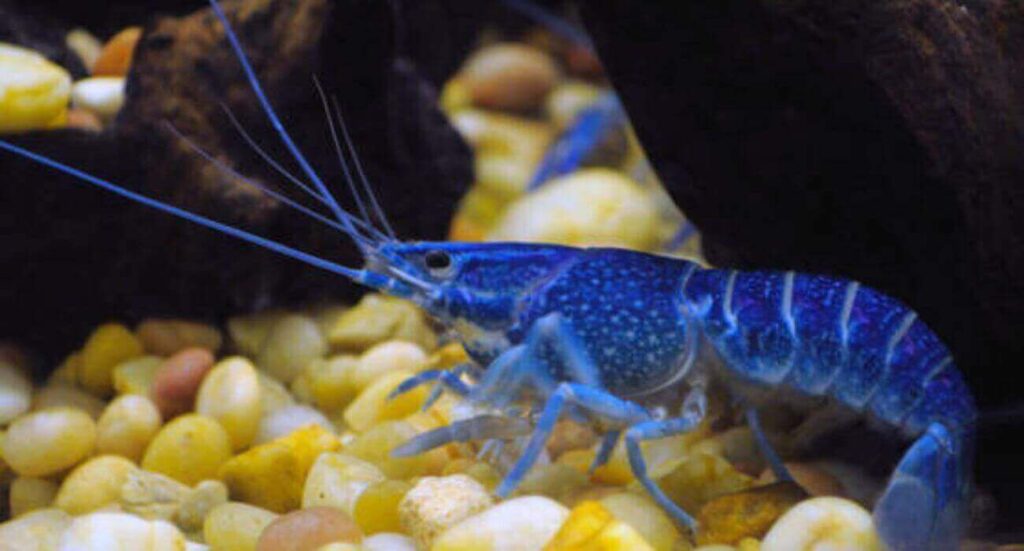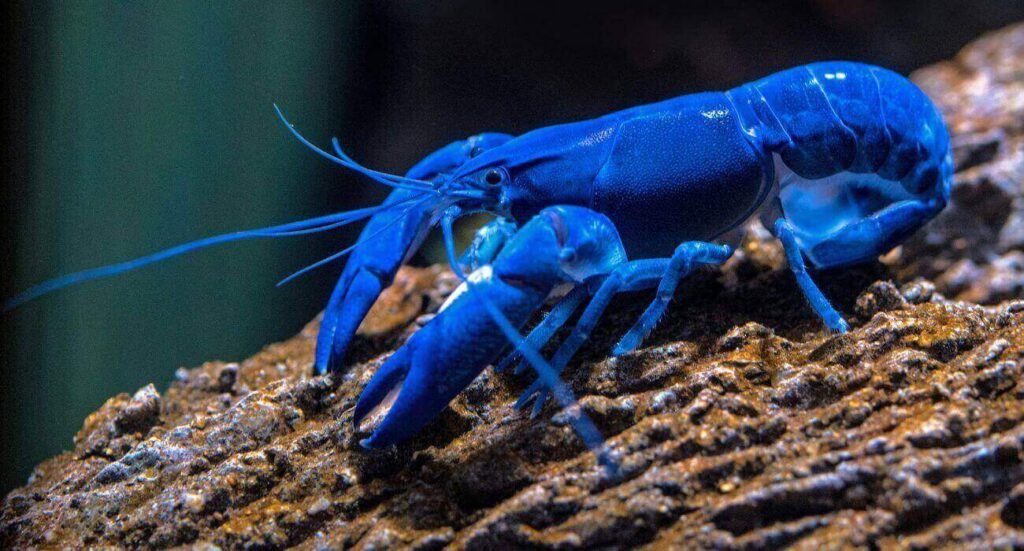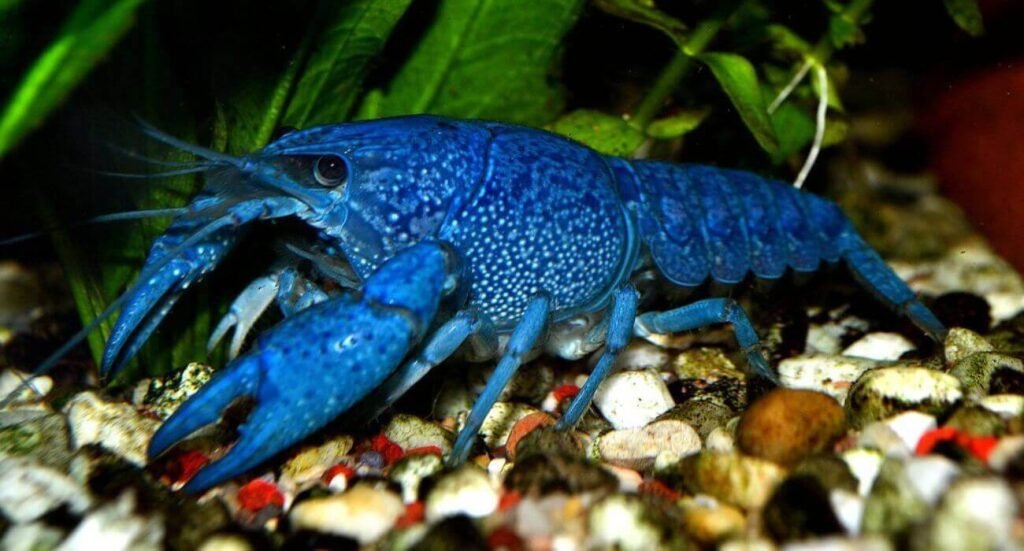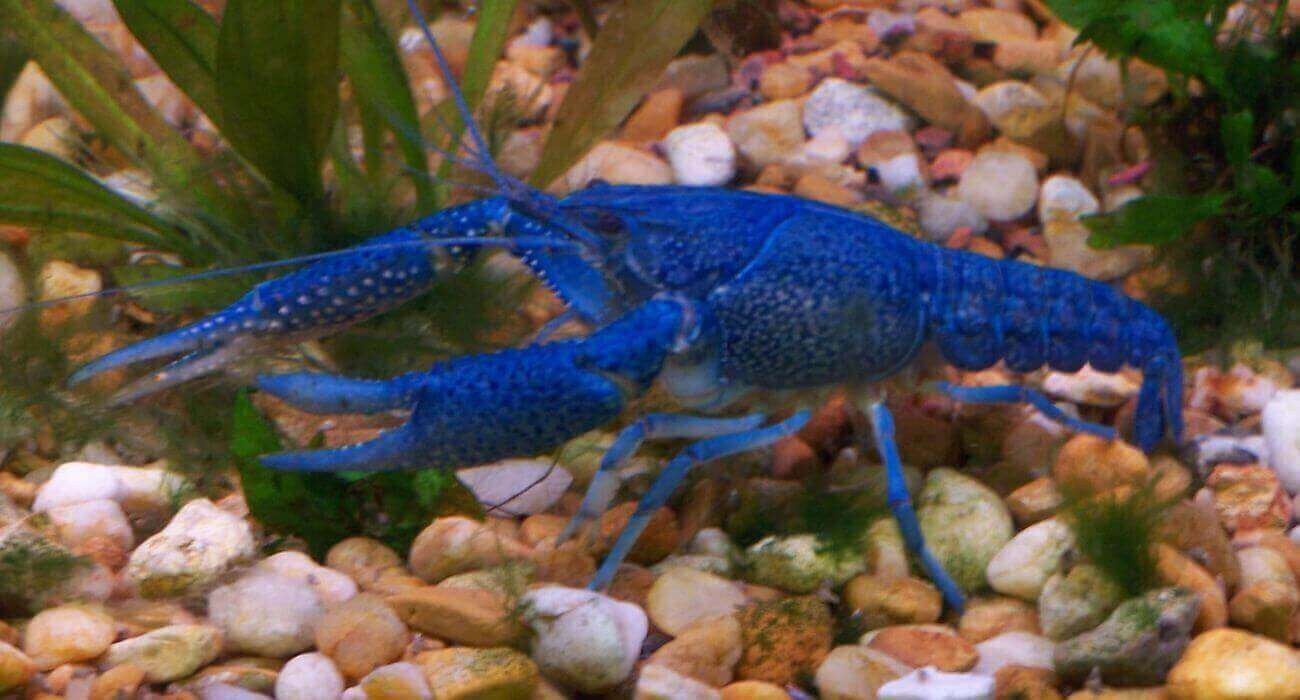As an Amazon Associate, I earn from qualifying purchases
Crayfish turn blue due to a genetic mutation that affects their pigmentation. This rare mutation reduces the production of red and yellow pigments, highlighting the blue.
Crayfish, also popularly known as crawfish or crawdads, are intriguing crustaceans found in various freshwater habitats. Normally, these creatures display earthy tones like brown, green, or red, which help them blend into their natural environments. But occasionally, a crayfish will boast a striking blue hue, captivating both aquarists and scientists alike.
This blue coloration is the result of a genetic anomaly that disrupts the normal pigmentation process. Such mutations are not just visually interesting, they also provide valuable insights into genetics and can make these blue crayfish highly sought after by collectors and enthusiasts. Understanding the causes behind this color variation is essential for both conservation efforts and the aquaculture industry.
The Blue Crayfish Phenomenon
Imagine a crayfish so vibrantly blue, it seems like a jewel in freshwater. This isn’t a fantasy, but the reality of the blue crayfish. Let’s dive into the world of these colorful creatures and discover why some crayfish boast such an extraordinary hue.
Crayfish Basics: Colors In The Wild
Crayfish, also known as crawfish or crawdads, are freshwater crustaceans. They come in many colors, including brown, green, and red. These colors often blend with their habitat. This camouflage helps them hide from predators.
Spotlight On The Blue Variant
The blue crayfish stands out with its striking color. But why blue? It’s due to a rare genetic mutation. This causes them to produce more of a certain protein. This protein turns their shells blue. Blue crayfish are the same species as their brown counterparts. They just have a unique color that makes them special.
| Color Variant | Cause | Rarity |
|---|---|---|
| Blue Crayfish | Genetic Mutation | Rare |
| Brown/Green Crayfish | Common Pigmentation | Common |
| Red Crayfish | Less Common Pigmentation | Uncommon |
- The blue crayfish is a natural wonder. Keepers love them for their beauty.
- These crustaceans can live in various environments. Tanks with hiding spots are perfect for them.
- Despite their color, blue crayfish have the same needs as other crayfish. They eat plants and small animals.
Genetic Roots Of The Sapphire Hue

Ever wonder why some crayfish sport an eye-catching sapphire hue? The secret lies deep within their DNA. In this look into the genetic roots of their vibrant color, we explore how tiny changes can create a world of difference.
Unraveling The Genetic Code
The genetic code of a crayfish acts like a blueprint for its color. Scientists scour this biological manuscript to understand what paints these crustaceans blue. Like a master switch, certain genes command how colors appear in their shells.
- Crayfish colors: Usually, they’re brown or red.
- Blue crayfish: A hint of genius in their genes.
- Genetic research: Offers clues to their unique shade.
Mutations And Color Expression
A single genetic twist might be enough to transform a crayfish from its common color to dazzling blue. Mutations in their genetic material can turn off the production of certain pigments, allowing a sapphire shade to shine through.
| Pigment Type | Common Expression | Blue Mutation Effect |
|---|---|---|
| Red/Yellow Pigments | Typically present | Reduced or missing |
| Blue Pigments | Often hidden | Dominant and visible |
Mutation outcomes: Not all mutations lead to a blue crayfish. They show nature’s vibrant palette through simple genetic alterations. As we uncover more about genes and their functions, the more we understand these beautiful blue crayfish.
Color And Camouflage
The mysterious world of crayfish holds many secrets, one of which is their fascinating color changes. The dazzling blues of some crayfish aren’t just for show. They serve critical survival purposes. In this exploration of ‘Color and Camouflage’, we’ll discover how crayfish use their color for more than just beauty.
Adaptation To The Environment
Crayfish are masters of adaptation. Their color often reflects their habitat, enabling them to blend in with rocks, plants, and shadows. Crayfish develop unique color patterns based on the minerals and the nature of the water they live in. For instance, a particular type of crayfish might turn blue due to a genetic mutation that allows the absorption of specific pigments in their shells, making them more suited to their environments.
- High mineral content in water may influence blue coloring.
- Genetic mutations can cause distinctive blue hues.
- Limited exposure to predators can allow vibrant colors to thrive.
The Role Of Color In Survival
In the animal kingdom, color can mean the difference between life and death. For crayfish, color is a survival tool. A blue crayfish might use its unique coloring to:
- Avoid predators by blending into the blueish backgrounds of their habitats.
- Signal to other crayfish as a means of communication or finding a mate.
- Deter rivals with their striking appearance, which may suggest strength or good health.
These colorful adaptations ensure crayfish continue to thrive in diverse ecosystems.
Dietary Influence On Crustacean Color
Why do crayfish turn blue? It’s not just raw genetics at play; their diet significantly influences the range of colors we see. By understanding the link between what crayfish eat and their vibrant hues, we can learn how their diets have the power to alter their appearance.
How Nutrition Affects Pigmentation
The color of crayfish is largely due to pigments called carotenoids. These pigments are not naturally produced by crayfish. Instead, they come from their diet. Feeding on plants and small creatures rich in carotenoids results in brighter colors.
- Shrimp and leafy greens can boost pink and red tones.
- Krill can enhance red and orange.
- Eating blue-green algae can help maintain blue shades.
Can Diet Induce Color Changes?
Yes, a diet change can lead to a shift in crayfish coloration over time. Carotenoids in their food are deposited in their exoskeleton. This can enhance or shift their color.
| Diet | Possible Color Change |
|---|---|
| Red Algae | More Reddish Hue |
| Blue Algae | Deeper Blue Color |
Younger crayfish may show more color changes than adults. Their new exoskeleton can quickly reflect diet changes.
The Rarity Of Blue Crayfish

Blue crayfish stand out in the natural world. This unique color variant thrills both aquarists and scientists. It remains a genetic wonder. Crayfish typically showcase browns and greens. So, spotting a blue crayfish is like finding a hidden gem. But what causes this blue hue? And why are they so rare?
Understanding Population Dynamics
Genetics play a major role in the blue color of some crayfish. A specific genetic mutation causes this striking blue shell. Most crayfish populations do not have this mutation. This makes blue crayfish very special.
- Mutations are rare.
- Natural selection often favors camouflage. Bright colors can attract predators.
- Blue crayfish are sought after by collectors. This can affect their numbers in the wild.
These factors combined mean blue crayfish are not common. They exist in small, secret pockets in nature.
Conservation Status Of Unique Crayfish
Conservation is key for these rare blue variants. Some blue crayfish species are at risk. Habitat loss and over-collection are big threats. Protecting these creatures is important.
| Threat | Impact on Blue Crayfish |
|---|---|
| Habitat Loss | Reduces living space for crayfish. |
| Over-collection | Lowers wild populations. |
Conservation efforts include breeding programs and habitat protection. Research helps us understand how to help these blue beauties survive.
- Establishing protected areas supports biodiversity.
- Captive breeding programs can help to increase numbers.
- Public education is vital. It promotes awareness and conservation.
Protecting the blue crayfish helps preserve the natural diversity of our waterways.
Breeding And Commercial Appeal
The vibrant shift to blue in some crayfish has intrigued both pet enthusiasts and breeders alike. This unique coloration is not only a visual spectacle but also an alluring trait for the commerce of ornamental pets. Let’s delve into how selective breeding has enhanced the presence of blue crayfish in the market and the economic implications tied to these color variants.
Selective Breeding For The Pet Trade
Eye-catching blue crayfish are highly sought after in the pet trade. Their unusual hue sparks interest and commands attention from aquarists around the world. Breeders employ selective breeding techniques to amplify the likelihood of producing progeny sporting the striking blue shell. This process involves:
- Identifying and pairing crayfish that exhibit blue characteristics.
- Monitoring offspring for the desired color trait.
- Continuing the cycle to establish a stable line of blue crayfish.
These methods ensure that the radiant blue coloration remains prevalent and becomes a signature trait within the species available for purchase.
Economic Implications Of Color Variants
Blue crayfish don’t just capture the gaze of hobbyists; they also represent a special segment of the market with significant economic implications:
- Blue crayfish typically command higher prices compared to their traditional counterparts due to their rarity and aesthetic appeal.
- Increased demand for unique pets encourages breeders to invest more in the propagation of these variants.
- Color variants such as the blue crayfish can boost the economic vigor of local aquaculture industries.
Therefore, the pursuit of blue crayfish is not only a matter of personal taste but also a strategic economic move for breeders and sellers within the ornamental pet industry.
Environmental Factors Contributing To Coloration
Have you ever wondered why crayfish can be a vibrant blue? This striking color change often links to their environment. Let’s explore the factors that paint these freshwater creatures in such vivid hues.
Water Quality And Its Effects
Water quality plays a vital role in crayfish color. Clear, clean water tends to enhance the blue pigment. Here are some key aspects:
- pH levels: Ideal ranges can affect color vibrancy.
- Mineral content: Minerals like calcium and magnesium are crucial.
- Oxygen levels: High oxygen water can contribute to brighter colors.
- Toxins and pollutants: These can cause stress, dulling the color.
Habitat Conditions That Influence Hue
The crayfish’s living conditions have a direct impact on their color. Look at these habitat factors:
- Substrate type: Dark or light grounds can alter their appearance.
- Available cover: More hiding spots can influence color intensity.
- Food sources: Diet contributes to pigmentation.
- Presence of predators: The need to camouflage can change colors.
Human interaction such as urban runoff or farming can also affect crayfish color. Remember, a blue crayfish is a sign of a healthy habitat!
Exploring Myths And Misconceptions

The world of crayfish is full of vibrant colors and patterns. Among these, blue crayfish stand out, sparking curiosity and old wives’ tales. Let’s dive into the myths and misconceptions that surround their unique coloration.
Debunking Folklore About Blue Crayfish
For generations, stories have woven a web of mystery around blue crayfish. One popular tale suggests these creatures are descendants of royal sea life, chosen by nature to don a regal blue. Another narrative implies blue crayfish bring luck to those who find them. But let’s peel back the layers of these whimsical stories to reveal the truth.
- Color does not denote royalty in the wild world.
- Luck is a human concept, not applicable to the life of a crayfish.
Scientific Explanations Vs. Popular Beliefs
When it comes to blue crayfish, science offers clear answers. These explanations dispel common beliefs rooted in mysticism rather than fact.
| Popular Belief | Scientific Explanation |
|---|---|
| Blue crayfish have magical qualities. | Their color is a result of genetic variance, not magic. |
| They are painted by mythical sea entities. | Blue is due to a specific pigment called astaxanthin. |
Understanding that genetics and biochemistry explain the blue hue breaks down old myths. It highlights the real, yet no less remarkable, world of crayfish.
Future Research Directions
The mystery behind crayfish turning blue sparks a world of potential studies. Research in this area not only unravels the secrets of crayfish coloration but also sheds light on broader ecological impacts. Below, we explore key areas where future investigations could lead to exciting discoveries.
Potential Studies On Crayfish Coloration
Scientists are keen to understand why some crayfish boast vibrant blue hues. Here is a glimpse into possible research inquiries:
- Genetic Factors: Exploring the crayfish’s DNA to find blue-color genes.
- Environmental Influences: Examining how water quality affects color.
- Dietary Impacts: Assessing the role of food in color changes.
- Behavioral Correlates: Observing color patterns linked to mating or survival.
Implications For Biodiversity And Ecosystems
The blue color of crayfish could signify more than meets the eye. Potential research might reveal:
| Aspect | Research Focus |
|---|---|
| Biodiversity Indicators | How crayfish color variations help monitor ecosystem health. |
| Predation and Survival | The effect of blue coloring on predator-prey dynamics. |
| Species Interactions | Understanding if color affects crayfish social structures. |
| Conservation Strategies | Using coloration patterns to develop protective measures. |
Each of these studies could lead to remarkable breakthroughs in ecological science. The blue crayfish continues to dazzle researchers and enthusiasts alike.
Frequently Asked Questions On Why Do Crayfish Turn Blue
Why Does A Crawfish Turn Blue?
A crawfish turns blue due to a rare genetic mutation that affects its pigmentation, resulting in a unique blue shell coloration instead of the typical red or brown.
Why Do Crawfish Change Colors?
Crawfish change colors due to cooking, which turns them red as heat denatures their pigments. Molting can also cause color variation, reflecting new shell growth.
Can Crayfish Be Blue?
Yes, crayfish can be blue. This unique color variation is rarer than the common red or brown shades, often resulting from genetic mutations.
How Rare Is A Blue Crawfish?
Blue crawfish are quite uncommon, with an estimated occurrence of one in 2 million in the wild.
What Causes Crayfish To Turn Blue?
Crayfish turn blue due to a genetic mutation that affects the pigmentation in their shell, resulting in a blue rather than the typical reddish-brown color.
How Common Are Blue Crayfish?
Blue crayfish are relatively rare in the wild compared to their more common brown counterparts, making them a unique find for enthusiasts.
Can Blue Crayfish Breed With Other Colors?
Yes, blue crayfish can breed with other colors, but the offspring’s coloration depends on the genetic dominance of the blue hue.
Do Blue Crayfish Require Special Care?
Blue crayfish require the same care as other crayfish, including clean water, a proper diet, and regular tank maintenance.
Will Cooking Change A Blue Crayfish’s Color?
Like other crayfish, blue crayfish will change color when cooked, typically turning red due to the heat denaturing their pigments.
Are Blue Crayfish More Aggressive Than Others?
Blue crayfish do not exhibit more aggression than crayfish of other colors; they share similar behavioral patterns irrespective of their shell color.
Conclusion
Understanding the fascinating transformation of crayfish to a striking blue hue is a journey through biology and chemistry. We’ve discovered it’s not just for aesthetic appeal but a sign of environmental and physiological changes. Keep observing and appreciating these colorful creatures, as each shade shift tells a unique story of nature’s intricate workings. Embrace the wonders of crayfish, and their vibrant color will continue to intrigue and educate us all.
As an Amazon Associate, I earn from qualifying purchases

